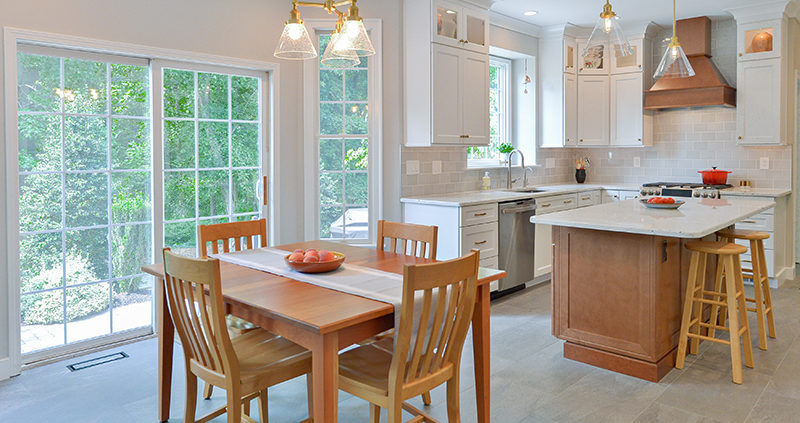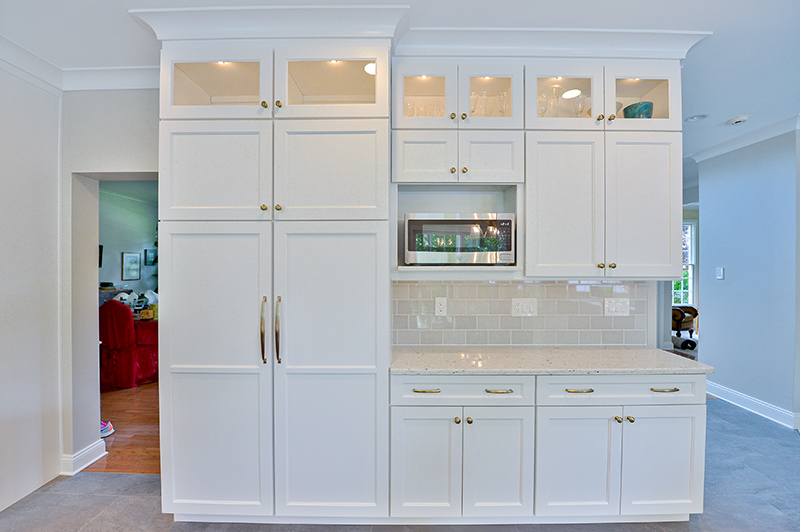Achieving a Timeless Kitchen Design
Kitchen design trends come and go (do wallpaper, linoleum floors, and pastel-colored appliances make you feel any sort of way?), but there are a handful of principles we can abide by to ensure a truly timeless kitchen design. Having the benefit of centuries worth of hindsight, we can much more readily identify the biggest hits and misses — there’s a reason certain things disappear while others stick around. Because it’s 2021, your kitchen remodeling options are wide open — and ultimately, it’s about what you like. But if it’s staying power you’re after, read on.
Distinguishing features of kitchen design
In the broadest strokes, today’s kitchen designs fall into one of four major categories — and although the distinctions between them can be vague, they can give us a general sense of where a customer’s head is at.
Traditional kitchen design
When we talk about traditional kitchen design, we are generally referring to those that reference Old World and American colonial traditions, pre-dating the 20th century. These kitchens are marked by ornate detailing and natural materials such as wood and stone — after all, the technology to create the man-made materials did not exist before then.
Although the term “traditional” or “classic kitchen” is a little ambiguous and not fully reflective of the diversity of architectural and cultural sensibilities here, you can generally expect things like raised cabinet panels, decorative mouldings, warm kitchen lighting from chandeliers, pendants, and sconces, stone backsplashes, and kitchen countertops made of marble, soapstone, or limestone. Because modern appliances were also not invented yet in these kitchens’ heyday, the oven was the focal point.
Modern vs. contemporary kitchen design
The term “modern kitchen design” is often used interchangeably with “contemporary kitchen design,” but the two are not one and the same. Modern kitchen design harkens back to a particular span of the 20th century, from approximately the 1920s into the 1970s. Encompassed within that are several design movements, including Art Deco and Mid-Century Modern. The latter has enjoyed a comeback in recent years, embracing an earthy color palette, flat paneled cabinet doors (painted or woodgrain), and furniture with curved or rounded edges.
Contemporary kitchen design, on the other hand, is about the aesthetic sensibilities of the here and now. In the 21st century, it’s most often associated with cleaner, more simplified lines and total composition. Colors are generally still neutral, but designers may judiciously incorporate a brighter color somewhere for visual interest — perhaps an accent wall or a backsplash. Glass and stainless steel have become increasingly popular materials. Recessed and track lighting have taken precedence.
Transitional kitchen design
Transitional kitchen design seeks to blend traditional and contemporary details in seamless fashion — white or off-white is the most popular color scheme, but blues, grays, greens, and beiges can also work beautifully. Natural and manmade materials are equally valid options with a transitional approach — it’s all about the right mix and balance, and whether the client wants to lean more traditional or contemporary. Cabinets (usually Shaker style, but painted or stained?) and countertops (marble, quartz, or solid surface?) are key to this. Whatever the design decision, it’s all about looking crisp and clean.
So what makes a timeless kitchen design?
Timeless kitchen design is concerned with what will always look good and function well, independent of trends or fads. A few best practices:
- Favor neutrality over flash in your color scheme — white cabinets or countertops may sound boring to some, but they’re extremely popular now, have been historically popular, and will likely continue to be popular in the future.
- Use high quality, natural materials whenever possible. Not only will they hold up better, they’ll create a more organic sense of space.
- Simplicity and cleanliness of lines — think Shaker style cabinets, subway tiles, etc. Transitional kitchen design has been in vogue in recent years because it does embrace these “timeless” qualities
- Lighting to tastefully illuminate work spaces and entertaining areas.
- A kitchen layout that works with you and not against you.
Timeless kitchen design in action
This recent kitchen remodel in Mickleton, NJ pulls together both traditional and contemporary elements for a look that’s both transitional and timeless. White Shaker style cabinets surround the perimeter of the workspace, with natural wood cabinets composing the center island. Soft, neutral colors are present in the stone flooring and ceramic subway tile backsplashes. Recessed lighting generally illuminates the space, while pendants accent the dining area and island.
At Ayars Complete Home Improvements, it is our hope that every project stands the test of time, bringing together craftsmanship, expertise, and communication to achieve the best possible result. Let’s cook up something special together.





